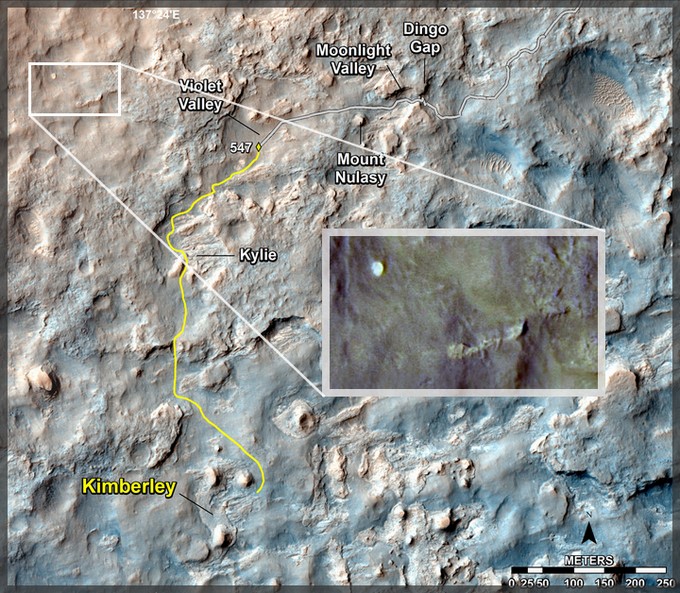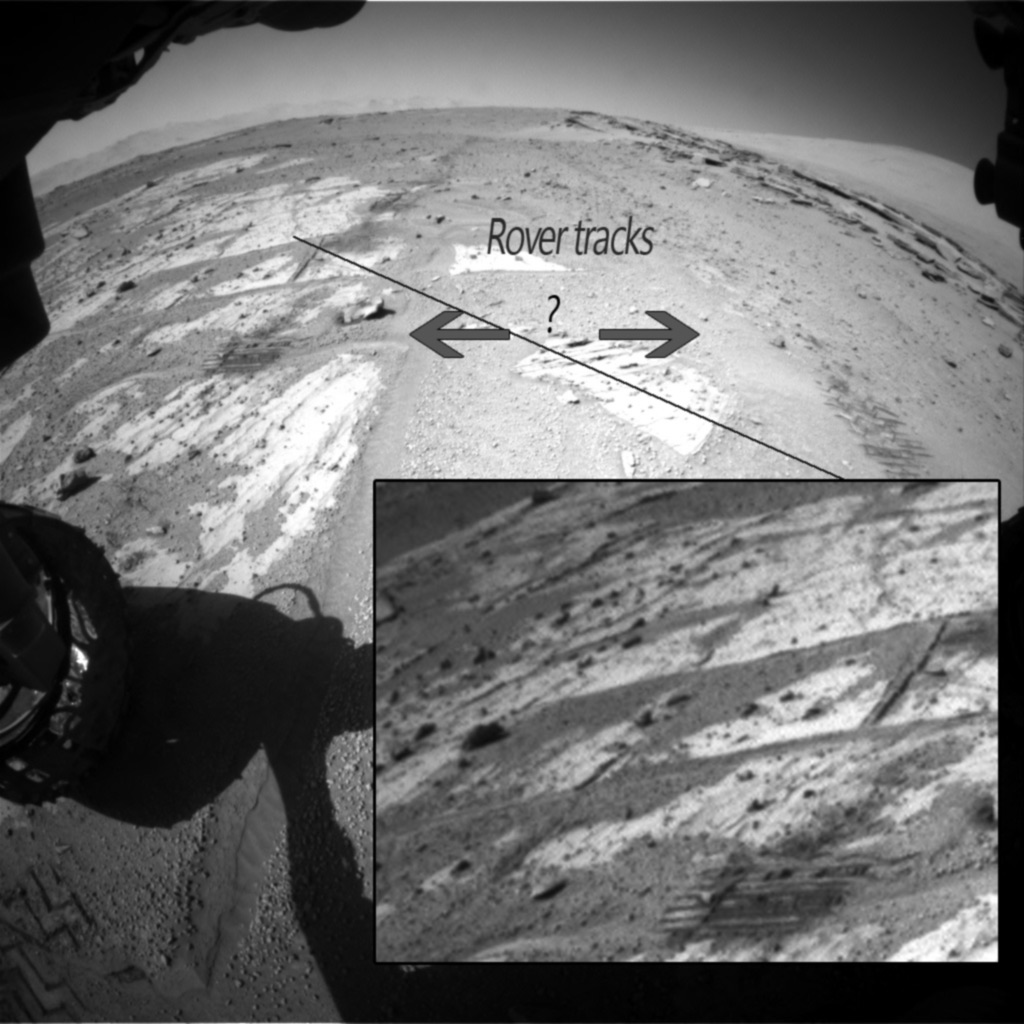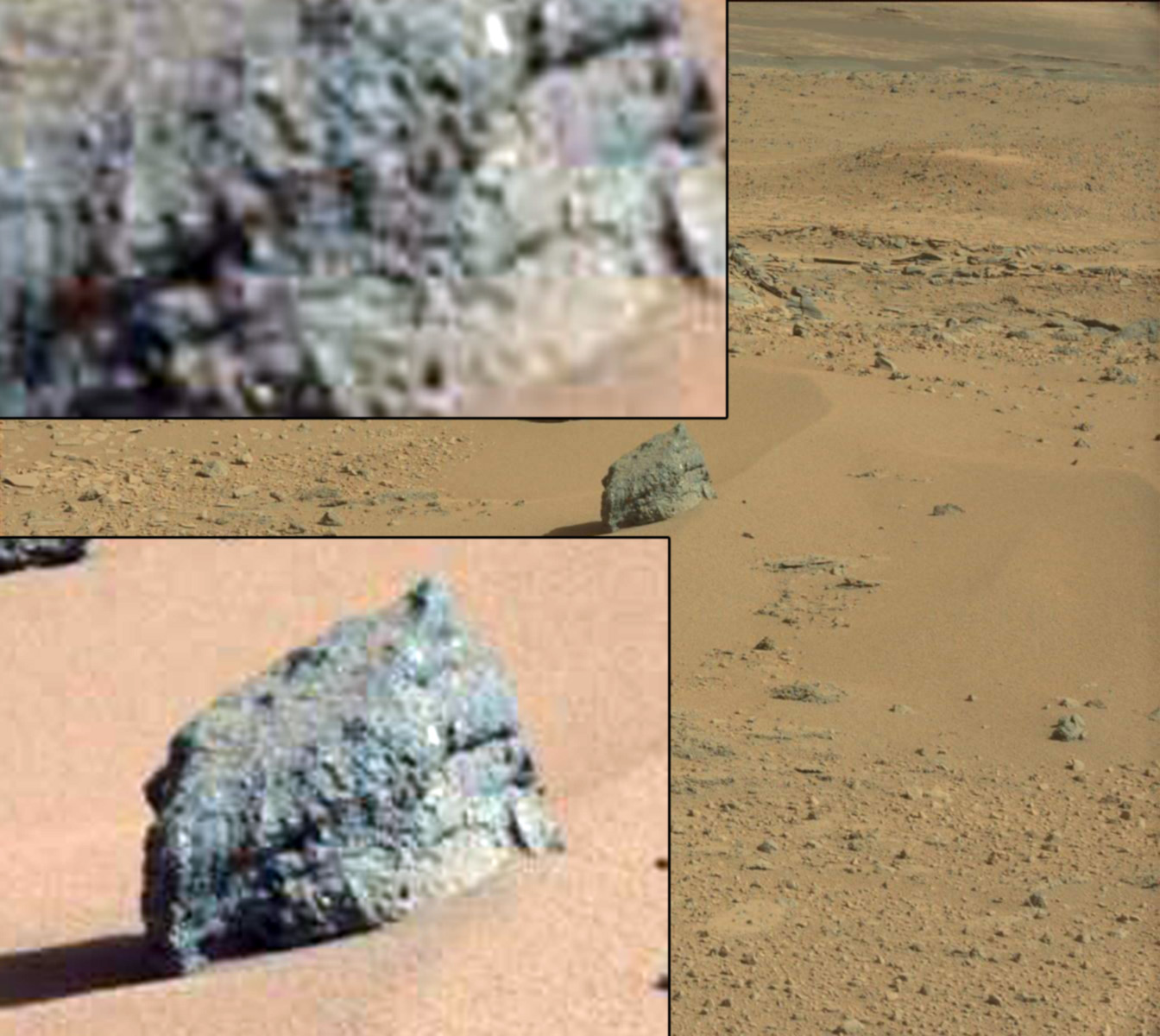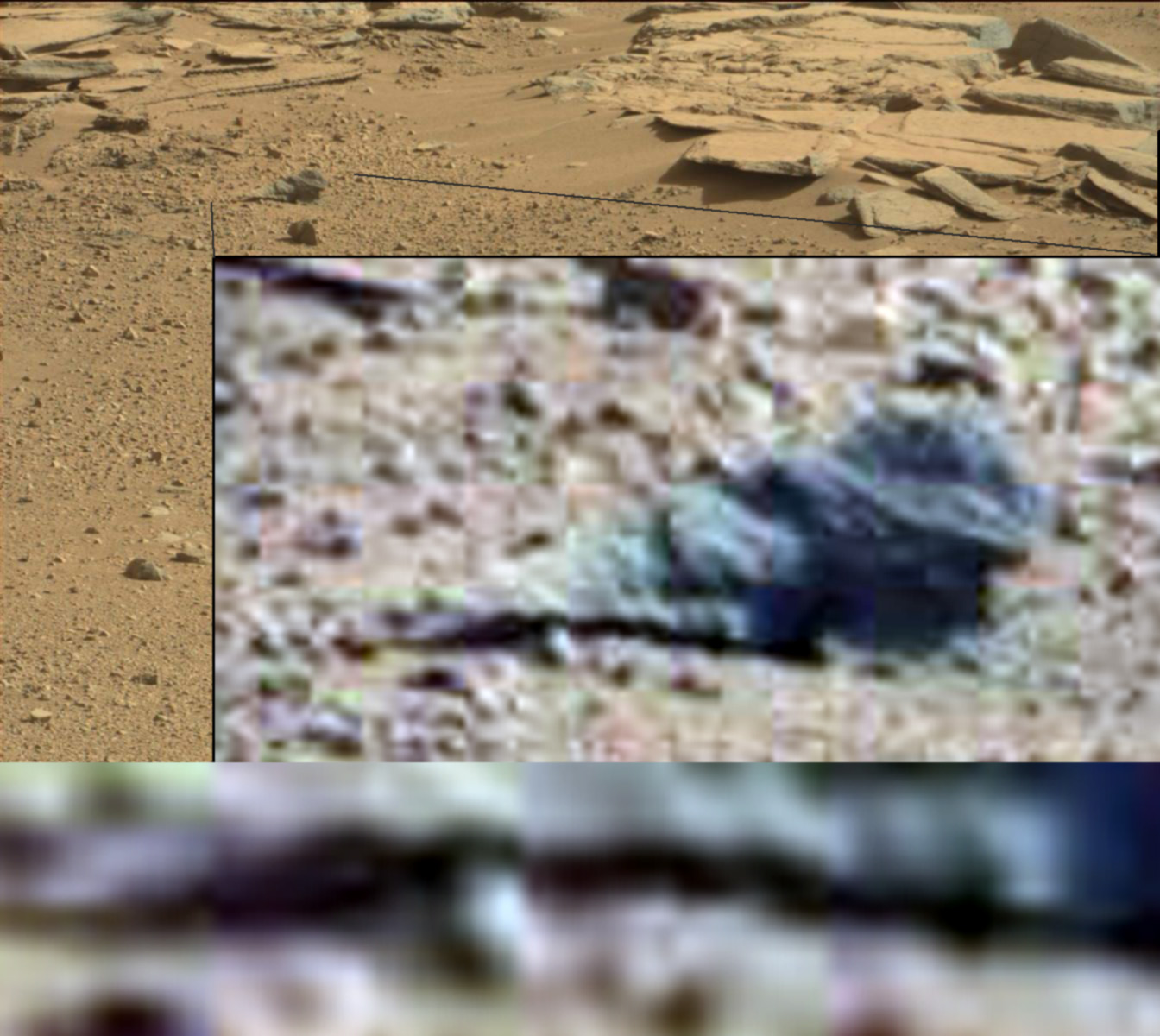It looks like you're using an Ad Blocker.
Please white-list or disable AboveTopSecret.com in your ad-blocking tool.
Thank you.
Some features of ATS will be disabled while you continue to use an ad-blocker.
share:
Aleister
reply to post by funbox
The goddess of Mars, who would that be? The only one that comes to mind in Dejah Thoris, the one from the books, not the recent movie.
Those two square things looking very similar, lined up next to each other (we should do an analysis of how close they may be, what the angle of alignment is, things with geometry involved which leaves me out), seem quite interesting. At least I'm interested in seeing them. Good find, aye.
The slugrock, which is actually a ways from the rover and so the details of its shell-crack seem to be hard to differentiate from image artifacts (I thought it was closer), but the undulations of its slug feature seem to be there.
The way I was looking at it was from the other end - that Donald Duck's head was the shell, eyes set up in there, and the long beak, and what I was seeing was his body, hip, and flipper feet down below. Sooooo, changing perspective, seeing it as a slug coming out of a shell, I catch an entire section of the object which I thought was sand, and see that it's connected. Very interesting, and like you said, the undulations along the side of the crawling thing, quite remarkable. I agree on its rough skin, it would have to have an underbelly of sandpaper consistency. And then the shell with the shell-like undulations along its mouth, but even without those being unclear as to if they are photo artifacts or not, nice shell-undulation "illusion" (?). Will post it again and see if I forgot things about it, I'm not looking at it as I write. By the way, this is me taking the point of view of it being alive, or close to it. For the "it's rocks" point of view, I can say it's rocks. So describing it as a lifeform is both more fun and longer to do ("rocks" is one word, doesn't take up much space), especially if there is a small percentage that it actually is. For visitors to this thread, see how fun that is? Please, if we have any anatomy folks reading these things, there are lots of objects to have a good time describing now.
edit on 19-2-2014 by Aleister because: (no reason given)edit on 19-2-2014 by Aleister because: (no reason given)edit on 19-2-2014 by Aleister because: (no reason given)
a slugrock, my imagination is really going to town on this extremophile / non carbon based life forms, an this is turning out to be my favourite , but I have this feeling this is not the first time ive seen this rock thing, dejavu is mixing in with it , but anyway great analysis, did you see the eyefold along is movement muscle? looks big enough to keep out them pesky dust devils , and the scathing martian breeze
funBox
Char-Lee
funbox
reply to post by Char-Lee
great comparison , a seaslug in a half shell , but how rough would that skin be in such a harsh and arid environment? an enamoured mars slug battled hardened for the blue it tribes sand food foraging attacks
what kind of creature was that spiral thing ?
funBox
I love it because the spiral was a mystery for a long while, it was neither animal not plant! it was a burrow, fossilized! Cool!
amazing , I guess the creature must have been a burrower of some sort , did they ever find out what created it , or does th e mystery continue?
funBox
edit on 20-2-2014 by funbox because: W
I often see these posts and on other threads as an amazing testament to how perception differs among people.
We all have eyes...yet the picture translates differently in our brains.
We all have eyes...yet the picture translates differently in our brains.
MarioOnTheFly
I often see these posts and on other threads as an amazing testament to how perception differs among people.
We all have eyes...yet the picture translates differently in our brains.
As does the entire world. When we are babies we have to learn to fit "names" and "uses" to light, color, and shadows created in our brain. We then learn what other people are seeing these things as, and gradually build a picture of the agreed-upon world. This does become apparent on these Mars images, and when someone else points out their take on them I can usually then "see" what they are seeing to a point (can never be quite sure if it's the exact same thing unless we are in the same room and draw a collective picture of it). I have a thread up concerning what I consider the best example of cloud images/faces in "history" (since they are all on one picture, a historic picture - and when you see all the images/faces in context, what a picture!), although not everyone can see them. But we all live in different universes, so sharing our take on the Mars objects with each other expands their possibilities as well.
An aside. My personal experienced favorite example of this occurred when I was walking one day and saw a snake on the path ahead of me. My brain held to the belief that it was a snake for so long - maybe a second - that it started to move, snakelike, until...I saw it was a tree stick (darn, just now I realized I should have kept it). Just a stick, and I saw the snake move. That was really a lesson for me in how our brain reads out the environment.
edit on 20-2-2014 by Aleister because: (no reason given)
funbox
uncertain to what the little round thing is ? a sandtrap?
unusual plateau , the way the rocks faces angle in towards the cliff , struck me as odd
funBox
Here goes the planned travel-route as of 18 February 2014 (in yellow):

Looks like Curiosity is not going to take a closer look at the round, disc-like formation we discussed on pages 58 and 59. Nevertheless, I believe she's going down a very interesting avenue on her way to Kimberly ... (SOURCE).
P.S.: Perhaps the formation will still be visible from a distance ...
reply to post by jeep3r
Thanks, that sure looks like an interesting run along the valley of the Martian Kings. It should be very enjoyable seeing all of the images coming back from this route! Maybe you can post that image on Blister's very good Rover Destination thread: www.abovetopsecret.com...
__________________________
From your JPL (Jack Parsons Lives) source:
I was hoping they'd change the name of KMS-9, and I wonder what the backstory is to the new name, "Kimberley"? And that was a good haul, over 100 meters. Go, Curiosity, Go!
Thanks, that sure looks like an interesting run along the valley of the Martian Kings. It should be very enjoyable seeing all of the images coming back from this route! Maybe you can post that image on Blister's very good Rover Destination thread: www.abovetopsecret.com...
__________________________
From your JPL (Jack Parsons Lives) source:
This map shows the route driven and route planned for NASA's Curiosity Mars rover from before reaching "Dingo Gap" -- in upper right -- to the mission's next science waypoint, "Kimberley" (formerly referred to as "KMS-9") -- in lower left. The point labeled 547 on the route is where Curiosity finished a drive of 319 feet (100.3 meters) on the 547th Martian day, or sol, of the rover's mission on Mars (Feb. 18, 2014). The map's line to that point is the path actually traveled; the yellow line past that is a planned route.
I was hoping they'd change the name of KMS-9, and I wonder what the backstory is to the new name, "Kimberley"? And that was a good haul, over 100 meters. Go, Curiosity, Go!
edit on 20-2-2014 by Aleister because: (no reason given)
edit on 20-2-2014 by Aleister because: (no reason
given)
edit on 20-2-2014 by Aleister because: (no reason given)
edit on 20-2-2014 by Aleister because: (no reason
given)
Aleister
It should be very enjoyable seeing all of the images coming back from this route! Maybe you can post that image on Blister's very good Rover Destination thread: www.abovetopsecret.com...
Done!
I could imagine that terrain being similar to that of Yellowknife Bay, perhaps with less elevation and access to even older layers/strata? And you're, of course, right regarding the part-time geologist we'd desperately need on this forum/thread!
The thing that continues to puzzle me about the landscape and rocks in the Mars images is just how jagged they are. For a planet that is not
volcanically active, it seems curious that so much of the landscape remains rough and rocky after several billion years of scrubbing by the dust in
the wind. I understand that the atmosphere is not very thick, but we're talking about billions of years. It seems to me that the whole surface
should be smoother, with more sand dunes.
Otherwise, I have to wonder if Mars periodically and relatively frequently goes through recurring clouds of meteors/asteroids to such a degree that it really gets slammed enough to rough up the bulk of the surface. And then I have to wonder if we might not experience the same thing, and it contributes to our mass extinctions. Not just one big meteor hitting the surface, like Chicxulub, but relatively dense "clouds" of smaller meteors, too, perhaps encountered as we orbit the galaxy every 240 million years. Like the spokes of Saturn's rings.
That doesn't bode well for our future. (Although it's unlikely I'll live long enough to be affected by it.)
Otherwise, I have to wonder if Mars periodically and relatively frequently goes through recurring clouds of meteors/asteroids to such a degree that it really gets slammed enough to rough up the bulk of the surface. And then I have to wonder if we might not experience the same thing, and it contributes to our mass extinctions. Not just one big meteor hitting the surface, like Chicxulub, but relatively dense "clouds" of smaller meteors, too, perhaps encountered as we orbit the galaxy every 240 million years. Like the spokes of Saturn's rings.
That doesn't bode well for our future. (Although it's unlikely I'll live long enough to be affected by it.)
jeep3r
P.S.: Perhaps the formation will still be visible from a distance ...
I doubt it, both Curiosity's planed path and the white formation look to be in lower areas, so we will probably get some higher areas in between, blocking the view.
reply to post by Blue Shift
One thing I noticed about almost all Mars rocks is that they look brittle when compared with Earth rocks, so maybe they break more frequently and keep sharper edges because of that.
One thing I noticed about almost all Mars rocks is that they look brittle when compared with Earth rocks, so maybe they break more frequently and keep sharper edges because of that.
ArMaP
One thing I noticed about almost all Mars rocks is that they look brittle when compared with Earth rocks, so maybe they break more frequently and keep sharper edges because of that.
I suppose temperature extremes could account for it. But weathering like that on Earth usually results from ice wedging -- water seeping into cracks then expanding when it freezes, snapping off sharp bits of the rock. I don't think CO2 would weather Mars rocks the same way, but I could be wrong.
It still surprises me that stuff isn't smoother on Mars.
P.S. -- I did a little research, and while CO2 liquid doesn't expand, the gas does. So as CO2 gas gets inside a crack in a rock, it might expand when the sun heats the rock, and cause it to crack. Kind of like bread dough rising, but in the case of a rock, it splits apart. (Maybe?)
edit on
20-2-2014 by Blue Shift because: (no reason given)
reply to post by jeep3r
maybe , has any description been given for it , does nasa know ?, or are they going on the assumption of sandtrap , albeit one that cast a shadow, I've already run it through a gif , there was little change in its shadow accept once where it appeared yellowish , so I guessing that could have been a over exposed or incorrectly white balanced picture , or even taken at sunset... ahh well another interesting path is avoided, will have a look into the path more closely , im sure their heading into demonic land, will check the picture again, but if I remember from the satellite it looked to me as if the area had been carved by demonic natural forces , gnarly plus. anyhow
one thing I haven't seen yet , are there any pictures of the sunset on mars >? surely they must have taken a few
placeholder
funBOX
maybe , has any description been given for it , does nasa know ?, or are they going on the assumption of sandtrap , albeit one that cast a shadow, I've already run it through a gif , there was little change in its shadow accept once where it appeared yellowish , so I guessing that could have been a over exposed or incorrectly white balanced picture , or even taken at sunset... ahh well another interesting path is avoided, will have a look into the path more closely , im sure their heading into demonic land, will check the picture again, but if I remember from the satellite it looked to me as if the area had been carved by demonic natural forces , gnarly plus. anyhow
one thing I haven't seen yet , are there any pictures of the sunset on mars >? surely they must have taken a few
placeholder
funBOX
funbox
one thing I haven't seen yet , are there any pictures of the sunset on mars >? surely they must have taken a few
I have seen some, but it doesn't look as good as on Earth.
ArMaP
I have seen some, but it doesn't look as good as on Earth.
Agreed. Without the clouds and the thicker atmosphere refracting the sunlight and creating all the nice colors, it's pretty dull.
Checking in to see if there's any new stuff, and it looks like all of us took a night off. Maybe in anticipation of that really interesting area of
Mars coming up soon. Where the tall wall casts a nice enough shadow to show that the place could be lots of fun. Ah, question, does the Rover have a
flashlight or spotlight? That they could shine into shadows? If so, nice. If not, that could have been a good addition. Would have taken some kind of
light bulb that would have survived the rover's landing.
reply to post by ArMaP
Good, thanks. According to the article they've only used it once as of January 2013, so there is a lot of juice in those lights once they need them. I'd imagine, depending on the time of day and the map that was posted, some long shadows will be coming up shortly, and they may want to give a peek into some of those shadowed areas. But yes, I'm glad they thought to bring the lights along. They have a white light and an ultraviolet light:
From your source, from January of 2013:
Good, thanks. According to the article they've only used it once as of January 2013, so there is a lot of juice in those lights once they need them. I'd imagine, depending on the time of day and the map that was posted, some long shadows will be coming up shortly, and they may want to give a peek into some of those shadowed areas. But yes, I'm glad they thought to bring the lights along. They have a white light and an ultraviolet light:
From your source, from January of 2013:
The purpose of acquiring observations under ultraviolet illumination was to look for fluorescent minerals," said MAHLI Principal Investigator Ken Edgett of Malin Space Science Systems, San Diego. "These data just arrived this morning. The science team is still assessing the observations. If something looked green, yellow, orange or red under the ultraviolet illumination, that'd be a more clear-cut indicator of fluorescence."
edit on 21-2-2014 by Aleister because: (no reason given)
reply to post by ArMaP
have you any links to pics? I would be interested to see ,
was checking the front nav's earlier , is the rover going back on itself? , it appears that they are tracks , but check the ground indicated , are those cracks /marking caused by the rover , or are we looking at something unrelated to the rovers activity's

sol 548 front nav
funBox
have you any links to pics? I would be interested to see ,
was checking the front nav's earlier , is the rover going back on itself? , it appears that they are tracks , but check the ground indicated , are those cracks /marking caused by the rover , or are we looking at something unrelated to the rovers activity's

sol 548 front nav
funBox
reply to post by Aleister
yep , the pictures ar'nt super consistent , but there regular enough to keep this thread busy for 7/8/9 weeks
check the colours in this rock,

some very intense colours ,that red segment , I wonder if this is a similar material to the material found inside flippy, the vanishing rock
so 548 mast
funBox
yep , the pictures ar'nt super consistent , but there regular enough to keep this thread busy for 7/8/9 weeks
check the colours in this rock,

some very intense colours ,that red segment , I wonder if this is a similar material to the material found inside flippy, the vanishing rock
so 548 mast
funBox
reply to post by funbox
Nice color arrangement. That's another reason why we need a geologist on this thread, or a grad student who wants to play on it for awhile. One nice thing is that the Rover has some easy ground to travel over for awhile, without many of those big spikey sharp rocks to worry its tires. It can make some good headway for a little bit, but I hope it stops and pokes around once it gets into those tall walls. And it doesn't look like your white circle has been imaged again, but keeping my arms and nose crossed for that to happen.
So you ATS geologists, come on by and camp with us for awhile. I'll make the lentils and rice, so you won't starve as we show you about two hundred pictures for your expert analysis. It would have been fun to hear a geologist explain blueit away before he went missing.
Nice color arrangement. That's another reason why we need a geologist on this thread, or a grad student who wants to play on it for awhile. One nice thing is that the Rover has some easy ground to travel over for awhile, without many of those big spikey sharp rocks to worry its tires. It can make some good headway for a little bit, but I hope it stops and pokes around once it gets into those tall walls. And it doesn't look like your white circle has been imaged again, but keeping my arms and nose crossed for that to happen.
So you ATS geologists, come on by and camp with us for awhile. I'll make the lentils and rice, so you won't starve as we show you about two hundred pictures for your expert analysis. It would have been fun to hear a geologist explain blueit away before he went missing.
new topics
-
Spiritual Solstice
Short Stories: 17 minutes ago -
'Mass Casualty event' - Attack at Christmas market in Germany
Mainstream News: 10 hours ago
top topics
-
'Mass Casualty event' - Attack at Christmas market in Germany
Mainstream News: 10 hours ago, 26 flags -
Biden Nationalizes Another 50,000+ Student Loans as He Heads for the Exit
US Political Madness: 15 hours ago, 8 flags -
Search to Resume for MH 370
Disaster Conspiracies: 12 hours ago, 4 flags -
Sue Gray, Sir Keir Starmer's former Chief of Staff, Nominated for Peerage
Regional Politics: 14 hours ago, 3 flags -
Spiritual Solstice
Short Stories: 17 minutes ago, 0 flags
active topics
-
Why isn't Psychiatry involved?
Social Issues and Civil Unrest • 27 • : GENERAL EYES -
Smartest Man in the World Tells His Theory About What Happens At Death
Philosophy and Metaphysics • 51 • : whereislogic -
'Mass Casualty event' - Attack at Christmas market in Germany
Mainstream News • 91 • : Naftalin -
An Interesting Conversation with ChatGPT
Science & Technology • 30 • : GENERAL EYES -
Spiritual Solstice
Short Stories • 0 • : Naftalin -
Drones everywhere in New Jersey ---and Elsewhere Master Thread
Aliens and UFOs • 205 • : GENERAL EYES -
-@TH3WH17ERABB17- -Q- ---TIME TO SHOW THE WORLD--- -Part- --44--
Dissecting Disinformation • 3771 • : 777Vader -
Democrat Governors Hold Emergency Meeting With President Biden to Assess His Mental State.
2024 Elections • 119 • : TruthJava -
I have a friend. . .
General Chit Chat • 23 • : MRTrismegistus -
On Nov. 5th 2024 - AMERICANS Prevented the Complete Destruction of America from Within.
2024 Elections • 161 • : WeMustCare

